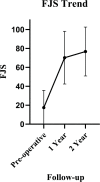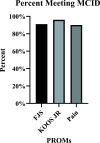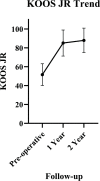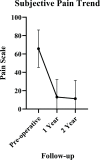Clinical results and patient-reported outcomes following robotic-assisted primary total knee arthroplasty : a multicentre study
- PMID: 35848995
- PMCID: PMC9350694
- DOI: 10.1302/2633-1462.37.BJO-2022-0076.R1
Clinical results and patient-reported outcomes following robotic-assisted primary total knee arthroplasty : a multicentre study
Abstract
Aims: The aim of this study was to report patient and clinical outcomes following robotic-assisted total knee arthroplasty (RA-TKA) at multiple institutions with a minimum two-year follow-up.
Methods: This was a multicentre registry study from October 2016 to June 2021 that included 861 primary RA-TKA patients who completed at least one pre- and postoperative patient-reported outcome measure (PROM) questionnaire, including Forgotten Joint Score (FJS), Knee Injury and Osteoarthritis Outcomes Score for Joint Replacement (KOOS JR), and pain out of 100 points. The mean age was 67 years (35 to 86), 452 were male (53%), mean BMI was 31.5 kg/m2 (19 to 58), and 553 (64%) cemented and 308 (36%) cementless implants.
Results: There were significant improvements in PROMs over time between preoperative, one- to two-year, and > two-year follow-up, with a mean FJS of 17.5 (SD 18.2), 70.2 (SD 27.8), and 76.7 (SD 25.8; p < 0.001); mean KOOS JR of 51.6 (SD 11.5), 85.1 (SD 13.8), and 87.9 (SD 13.0; p < 0.001); and mean pain scores of 65.7 (SD 20.4), 13.0 (SD 19.1), and 11.3 (SD 19.9; p < 0.001), respectively. There were eight superficial infections (0.9%) and four revisions (0.5%).
Conclusion: RA-TKA demonstrated consistent clinical results across multiple institutions with excellent PROMs that continued to improve over time. With the ability to achieve target alignment in the coronal, axial, and sagittal planes and provide intraoperative real-time data to obtain balanced gaps, RA-TKA demonstrated excellent clinical outcomes and PROMs in this patient population.Cite this article: Bone Jt Open 2022;3(7):589-595.
Keywords: Forgotten Joint Score (FJS); Joint Replacement; KOOS JR; Knee Injury and Osteoarthritis Outcomes Score; Patient reported outcomes; Patient-reported outcome measures; Robotic-assisted total knee arthroplasty; Robotics; Total knee arthroplasty; Total knee replacement; clinical outcomes; pain scores; patient-reported outcome measures (PROMs); primary total knee arthroplasty; total knee arthroplasties (TKAs).
Figures




Similar articles
-
No difference in clinical outcomes between functionally aligned cruciate-retaining and posterior-stabilized robotic-assisted total knee arthroplasty.Int Orthop. 2023 Mar;47(3):711-717. doi: 10.1007/s00264-023-05693-1. Epub 2023 Jan 17. Int Orthop. 2023. PMID: 36648533
-
Presence of back pain prior total knee arthroplasty and its effects on short-term patient-reported outcome measures.Eur J Orthop Surg Traumatol. 2022 Apr;32(3):541-549. doi: 10.1007/s00590-021-03010-3. Epub 2021 May 26. Eur J Orthop Surg Traumatol. 2022. PMID: 34037858
-
Image-Free Robotic-Assisted Total Knee Arthroplasty Results in Quicker Recovery but Equivalent One-Year Outcomes Compared to Conventional Total Knee Arthroplasty.J Arthroplasty. 2023 Jun;38(6S):S232-S237. doi: 10.1016/j.arth.2023.02.023. Epub 2023 Feb 18. J Arthroplasty. 2023. PMID: 36801477
-
Customised, individually made total knee arthroplasty shows promising 1-year clinical and patient reported outcomes.Arch Orthop Trauma Surg. 2021 Dec;141(12):2217-2225. doi: 10.1007/s00402-021-04045-1. Epub 2021 Jul 16. Arch Orthop Trauma Surg. 2021. PMID: 34269890 Free PMC article. Review.
-
Navigated and Robot-Assisted Technology in Total Knee Arthroplasty: Do Outcome Differences Achieve Minimal Clinically Important Difference?J Arthroplasty. 2022 Aug;37(8):1562-1569. doi: 10.1016/j.arth.2022.03.075. Epub 2022 Mar 30. J Arthroplasty. 2022. PMID: 35367335
Cited by
-
Early and delayed periprosthetic joint infection in robot-assisted total knee arthroplasty: a multicenter study.Eur J Orthop Surg Traumatol. 2024 Aug;34(6):3155-3162. doi: 10.1007/s00590-024-04043-0. Epub 2024 Jul 18. Eur J Orthop Surg Traumatol. 2024. PMID: 39026078 Free PMC article.
-
Survivorship in robotic total knee arthroplasty compared with conventional total knee arthroplasty: A systematic review and meta-analysis.Arthroplasty. 2025 Apr 8;7(1):21. doi: 10.1186/s42836-025-00304-3. Arthroplasty. 2025. PMID: 40197345 Free PMC article.
-
Objectively measured activity behaviours using the ActivPAL accelerometer following robotic and manually performed total knee arthroplasty : a feasibility study from a randomized controlled trial (ROAM study).Bone Joint Res. 2025 Jun 1;14(6):495-505. doi: 10.1302/2046-3758.146.BJR-2024-0239.R1. Bone Joint Res. 2025. PMID: 40449935 Free PMC article.
-
Development and validation of a nomogram for predicting a forgotten joint in patients one year after robotic-assisted total knee arthroplasty.BMC Musculoskelet Disord. 2025 May 31;26(1):536. doi: 10.1186/s12891-025-08789-4. BMC Musculoskelet Disord. 2025. PMID: 40450270 Free PMC article.
-
Comparative assessment of current robotic-assisted systems in primary total knee arthroplasty.Bone Jt Open. 2023 Jan;4(1):13-18. doi: 10.1302/2633-1462.41.BJO-2022-0070.R1. Bone Jt Open. 2023. PMID: 36602297 Free PMC article.

